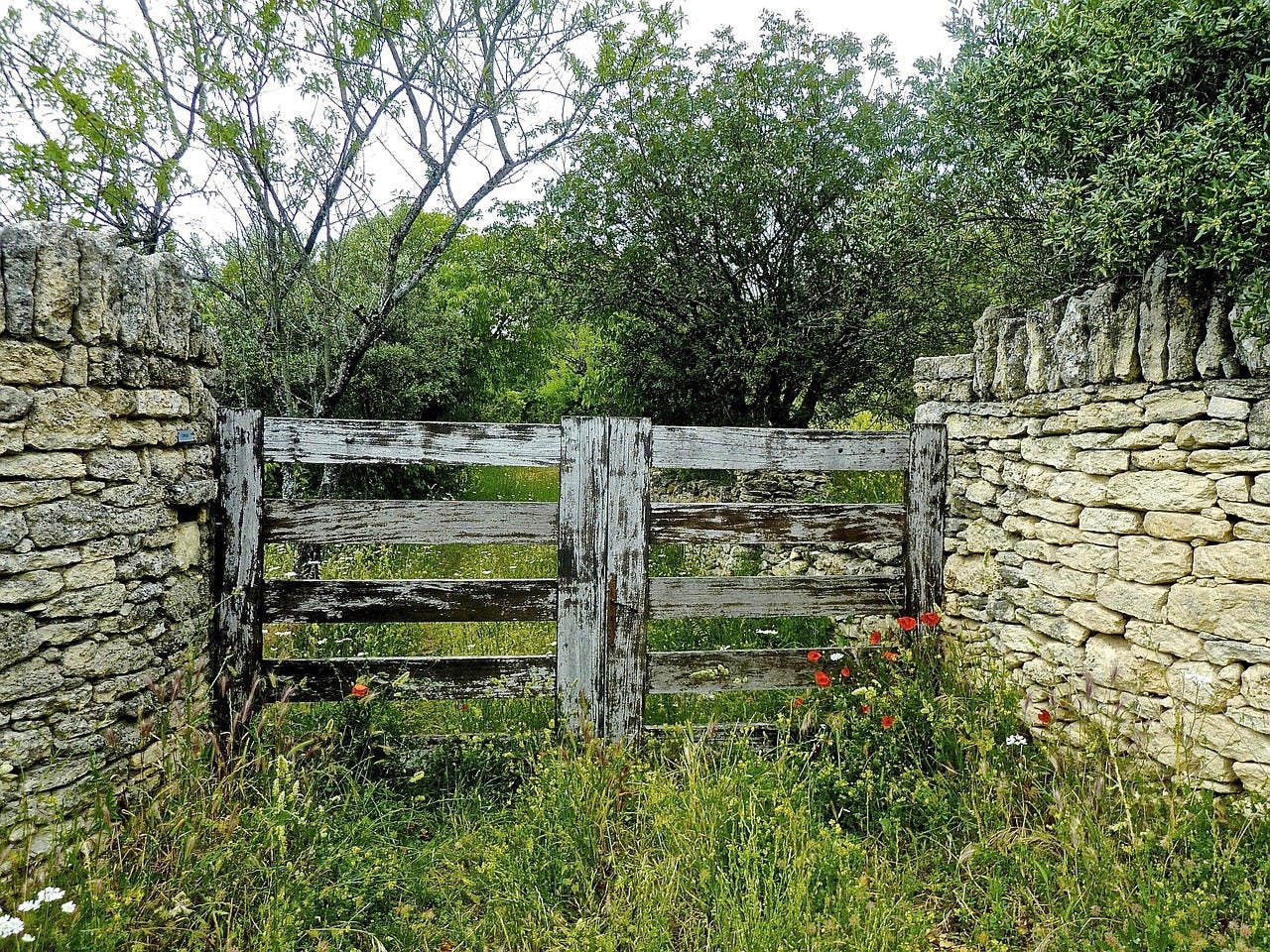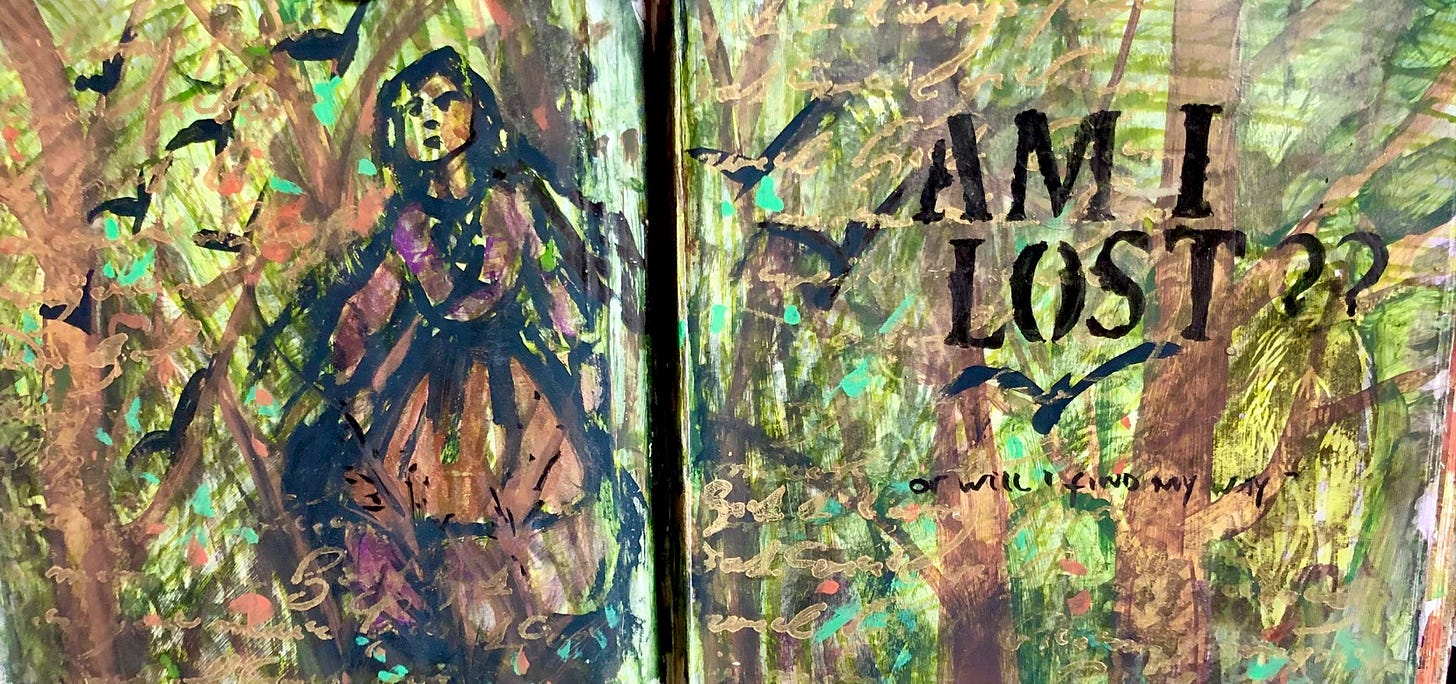Boundaries, Borders, Hedges and Edges
keeping things in and out
If you liked reading this, feel free to click the ❤️ button on this post so more people can discover it on Substack 🙏
Welcome!
For those new here, Hedge Mystic is a reader-supported publication where I explore spiritual topics in parallel with seasonal wisdom and creative practice.
All of my articles are free to read, but you can send me a one-time donation if you like my work, book a tarot reading, or upgrade your subscription to support me long-term.

Above you see one of my favorite pieces of art, an engraving that, for me, presents the ultimate edge, boundary, or border between one reality and another. There I am, cloaked in red and straddling the edge as I breach the border and peer into another world.
My curiosity and deep desire to understand reality as it truly is, to perceive both visible and invisible worlds, and to become acquainted with other orders of beings, have always been a powerful force in my life. This insatiable desire drives my intellectual pursuits, my creative work, my spiritual practices, and my more mundane passions, such as gardening.
It is the garden once again that presents itself as mentor and teacher. (and here I thought I was the gardener, designing, pruning, training, nurturing, when alas, I am only the humble student!)
Between the rains and before the heatwave, Summer Solstice week promises to deliver I am occupied with pruning. Not just the annual June Prune (or Chelsea Chop if you‘re on the other side of the pond) when you cut back later blooming, taller growing perennials to get more blooms and avoid flopping plants and having to stake top-heavy bloom stalks, no, this was serious pruning at the woodland edge.
Woodland edge pruning is always very nerve-wracking for me. Decisions have to be made. Important decisions. Life and death decisions, at least for the shrubs and trees that crop up like a hedge on the edge of my cultivated spaces.
I’ve come to realize over the years that I live on an edge. My home and all my activities are situated between worlds. My house and gardens sit in a dale, a gentle, low spot between two hills. Both of our neighbors' houses on either side are situated at a higher elevation than our house, and my front yard is at a higher elevation than the back—the entire back property slopes gently down to wetlands and a pond. The gardens are right at the boundary of the upland and the lowland. Then there’s the edge where dry land, marshland, and eventually water meet. This is a particularly potent edge, where I constantly experience interesting interactions with nature and its spirits.
More pertinent to this discussion is the edge of the woods. Our three-acre parcel can roughly be divided into thirds. The front yard and house are approximately one acre, the back yard and gardens another acre, and the wooded hill and pond the third acre. This, coupled with the woods that separate our land from both neighbors, means that the woods essentially surround my home and gardens.
Indeed, our entire parcel, along with all the other parcels on our cul-de-sac, was a mere fifteen years ago a wooded area. The woods would like to reassert themselves. They would do exactly that if I didn't intervene.
Some other time, I will tell you stories of my adventures befriending the land and its guardians, the mishaps, the mischievous things, and frankly, some spiteful things I experienced as the land initially resisted my gardening efforts. Fortunately, after a few years, I gained a better understanding of what was going on and was able to broker an alliance. Now there is general cooperation and appreciation.
I digress, back to the edge of the woods. Every year, oak, maple, hickory, tupelo, sassafras, birch, beech, and poplar saplings pop up at the edge of the woods in grassy areas, in the meadows I am creating, and in garden areas. Also, sumac, Virginia creeper, poison ivy, winterberry, mapleleaf viburnum, summersweet, sweetfern, blueberry, witchhazel, and several other things plant themselves in random places. There are, of course, also invasive species, such as bittersweet and Japanese Honeysuckle, that strangle other plants and trees. There is also the Kousa Dogwood and Bradford Pear, which, while beautiful when in flower, creep in and never leave, draining resources away from native plants that belong on the land.
In many ways, the woods on the other side of the stone wall are another world. Uncultivated, natural, wild. It’s home to many small animals and birds, and serves as a greenway for deer, foxes, coyotes, skunks, opossums, bobcats, fishers, and other wildlife.
This is where the woods themselves instruct me. First, there is the reminder that the woods are not my home. Not every denizen in the woods is safe. They are wild and live according to their own ways, following patterns of behavior that are not meant for humans. The same applies to trees and plants. Some are desirable, and I let them stay, flourish, appreciate them, and work with them. Others are invasive, and some are harmful. Many are beautiful and beneficial. It takes experience and wisdom to know which to remove and which to keep.
The same lesson applies to interactions with other realms and the beings that inhabit them. Those other realms are not meant for incarnate humans. Their ways are not our ways. What we can find there may be beautiful and beneficial, but they may also be dangerous and seek to encroach on your heart, mind, and body in a malevolent way.
This is why we need edges, and hedges in the garden, and borders and boundaries in our spiritual life. We live in a multifaceted reality with worlds both visible and invisible. Knowing what to interact with, what to let in, and what to keep out is crucial. Spiritual discernment is essential.

When you live near the hedge or on the edge, or find value and instruction from crossing borders into other lands, do so with care. Just as I've learned to recognize poison ivy, vines that choke, and invasive trees, I’ve also learned to see the warning signs that point to spiritual happenings emanating from a spirit of rebellion against the created order ordained by the Creator.
Some years ago, I was undergoing a complete dissolution of my understanding of spiritual truth. I would not say it was a crisis of faith, as my Christian faith never waivered, but how I understood my faith tradition and both greater and more general spiritual truths was changing. I was opening up to many new ideas, practices, and systems. I was crossing into new spiritual territory and letting things cross the threshold and take root in my spiritual garden. That was both an exhilarating and terrifying time. It was also necessary, even though I felt lost at times.
I grew tremendously during those years, and traversed far and wide through many esoteric and occult lands. In the end, I came back changed, with a new appreciation for the secure position I have within God and the power of the Spirit always to guide me.
Hedges, edges, boundaries, and borders are important because they mark territories and distinguish what should be kept in and what should remain out. But walls can be climbed, hedges parted, and some boundaries and borders have gates or doors.
One of the most remarkable things I have learned through years of spiritual travel and exploration is that while other invisible realms are certainly real, our material world is instrumental in teaching, imaging, and conveying spiritual truths. Our woods and fields, forests and waters are filled with natural magic that is powerful and good.
This summer I am dedicating myself to delving into the exploration and pursuit of natural magic. When I have some insights to share with you, you’ll see them pop up in Hedge Mystic from time to time.
Have a beautiful and blessed Summer Solstice and St. John’s Day. Soak in the sun, reflect on the Spirit, the Light of the World, and look upon the woods with wonder and enchantment in your heart.
Are you moved by this piece and want the Hedge Mystic Community to benefit and grow? Then, make a one-time donation. Click the Donate button below!
Thank you for reading Hedge Mystic and participating in this vibrant and growing community of creative, spiritual humans. You are always welcome here, appreciated, and loved.
Hedge Mystic is a reader-supported publication based on a value-for-value premise. If you find value in Hedge Mystic, support my work and consider becoming a paid subscriber. Your involvement and financial support are deeply appreciated. Thank you.




